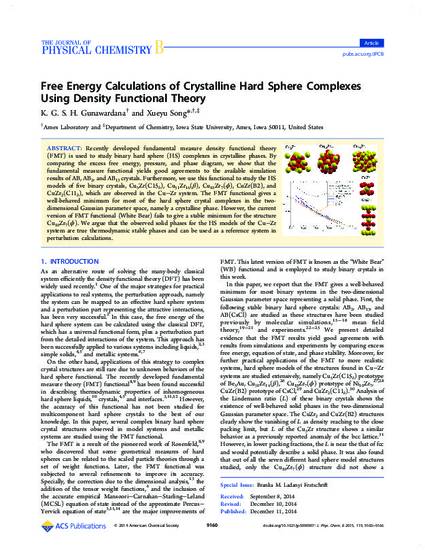
Article
Free Energy Calculations of Crystalline Hard Sphere Complexes Using Density Functional Theory
Journal of Physical Chemistry B
Document Type
Article
Disciplines
Publication Version
Published Version
Publication Date
1-1-2015
DOI
10.1021/jp5090907
Abstract
Recently developed fundamental measure density functional theory (FMT) is used to study binary hard sphere (HS) complexes in crystalline phases. By comparing the excess free energy, pressure, and phase diagram, we show that the fundamental measure functional yields good agreements to the available simulation results of AB, AB2, and AB13 crystals. Furthermore, we use this functional to study the HS models of five binary crystals, Cu5Zr(C15b), Cu51Zr14(β), Cu10Zr7(ϕ), CuZr(B2), and CuZr2(C11b), which are observed in the Cu–Zr system. The FMT functional gives a well-behaved minimum for most of the hard sphere crystal complexes in the two-dimensional Gaussian parameter space, namely a crystalline phase. However, the current version of FMT functional (White Bear) fails to give a stable minimum for the structure Cu10Zr7(ϕ). We argue that the observed solid phases for the HS models of the Cu–Zr system are true thermodynamic stable phases and can be used as a reference system in perturbation calculations.
Copyright Owner
American Chemical Society
Copyright Date
2015
Language
en
File Format
application/pdf
Citation Information
Koralagamage Gunawardana and Xueyu Song. "Free Energy Calculations of Crystalline Hard Sphere Complexes Using Density Functional Theory" Journal of Physical Chemistry B Vol. 119 Iss. 29 (2015) p. 9160 - 9166 Available at: http://works.bepress.com/xueyu-song/26/

Reprinted (adapted) with permission from Journal of Physical Chemistry B 119 (2015): 9160, doi:10.1021/jp5090907. Copyright 2015 American Chemical Society.